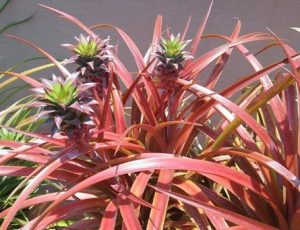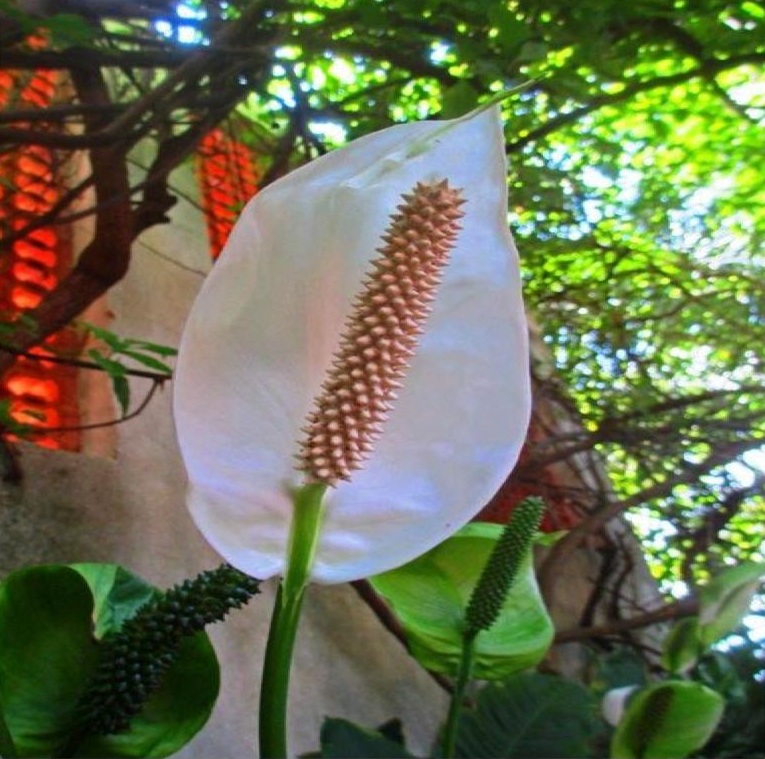By Tommy Clarkson from the November 2016 Edition
Dwarf Pineapples, Ananas cosmosus
Family: Bromeliad
Also known as: Pygmy Pineapple or Miniature Pineapple

The bromeliad genus of Ananas is comprised of fewer than ten base species, but now has, hundreds of cultivars. Foremost of the genus, in case we’ve forgotten, but as Andrew Steens notes in his book Bromeliads for the Contemporary Garden, is “the classic bromeliad of commerce, the pineapple.” Among these are some particularly prickly and petite ones.
These, some say, are all but inedibly acidic. Yet others claim that, cleaned, these pineapples can be eaten to and including the core. These intriguingly, diminutive pineapples aren’t sought for succulence or sweetness on one’s tongue but, rather, for their delight upon our eyes! They are those of the dwarf or miniature species. About these, frustratingly, little of depth or consequence seems to have been written . . . well, beyond the fact that they look great in flower arrangements and can be used as exotic drink stirrers!
In Ola Brisa Gardens we have three of these smallfruited variants: a white and a pinkish red both with fiercely armed margins of unforgiving hooked barbs, and a Pindo Pink with smooth, unarmed, maroon leaves. The white (Ananas comosus var. ananassoides) and the Pindo Pink (Ananas comosus var. bracteatus) sport pineapples of only two to three inches

(5.08-7.62 cm) tall. The pinkish-red plant has larger fruit around four to six inches (10.16-15.24 cm). Its Latin designation is Ananas comosus var. variegatus. (Please make no plans to take those Latin names to the proverbial botanical bank, as my ability to fully confirm them has been marginal, at best!)
These are native to Suriname and northern Brazil and much like Patty and me care not a tiny bit for environs where the temperatures drop below 60° F (15.56 C).
Regardless if grown inside or out, the miniature pineapple needs as much direct sunlight as possible. At least six hours of sunlight every day (including holidays) helps not only to warm the soil, but also to keep its foliage firm and well shaped. (Maybe that’s what I need!) Too little amount of sunlight can cause your plant to become leggy, its leaves to be too thin and is more than likely to reduce the chance for flower stalk production and the subsequent, sought after, fun looking fruits.
It grows best in a well-draining fertile, humusy soil. Sand-based soils with compost and mulch are the most ideal of growing conditions, if kept evenly moist during the growing season.
Avoid heavy clay soil or any that remains soggy after rain or watering.
Water freely during the growing season and when the flowering stalk is present with the soil kept moist from spring to autumn. Literally shower your Dwarf Pineapple allowing water to run through leaf gaps and crevices to the soil below. In the cooler season, reduce watering, keeping soil barely moist and allowed to dry out between waterings. Too much fertilizer can cause overly fast growth and limit the plant’s ability to create a flower stalk.

When the miniature pineapple begins to mature a bit (you know all the signs: argumentativeness, picking fights with younger siblings, refusal to do assigned household chores, begging to stay out past curfew) the center of its rosette of spiny leaves will produce a flower stalk. The stalk will elongate and rise above the foliage revealing a rounded cluster of lilac to red flowers with yellow bracts. Ultimately, this will look very much like a colorful pine cone! After these flower, it will create a small pineapple fruit with a large, sharp tipped, crown of foliage. Consider staking that stalk in order to maintain erect attractiveness. Continue to water it during this period so as to ensure that the flower and fruits do not wither and die prematurely.
Once the Dwarf Pineapple produces fruit, it’s destined to die. (Karma’s a bit of a bear!) But the family lineage can continue!
The top of the small fruit can perpetuate the family line by be-ing replanted. Beyond that, the mother bromeliad also will have developed small new plants called pups at her base. As this plant parent slowly declines in health, her pups increase in size. Once the mother plant has passed to the Great Garden in the Sky (or compost bin), cut it off at its base, but don’t damage the young pups. Then, on their own, they will grow quickly.
Within a year, they’ll be ready to flower and fruit, and continue the Circle of Life.
Download the full edition or view it online
—
Tommy Clarkson is a bit of a renaissance man. He’s lived and worked in locales as disparate as the 1.2 square mile island of Kwajalein to war-torn Iraq, from aboard he and Patty’s boat berthed out of Sea Bright, NJ to Thailand, Germany, Hawaii and Viet Nam; He’s taught classes and courses on creative writing and mass communications from the elementary grades to graduate level; He’s spoken to a wide array of meetings, conferences and assemblages on topics as varied as Buddhism, strategic marketing and tropical plants; In the latter category he and Patty’s recently book, “The Civilized Jungle” – written for the lay gardener – has been heralded as “the best tropical plant book in the last ten years”; And, according to Trip Advisor, their spectacular tropical creation – Ola Brisa Gardens – is the “Number One Tour destination in Manzanillo”.



